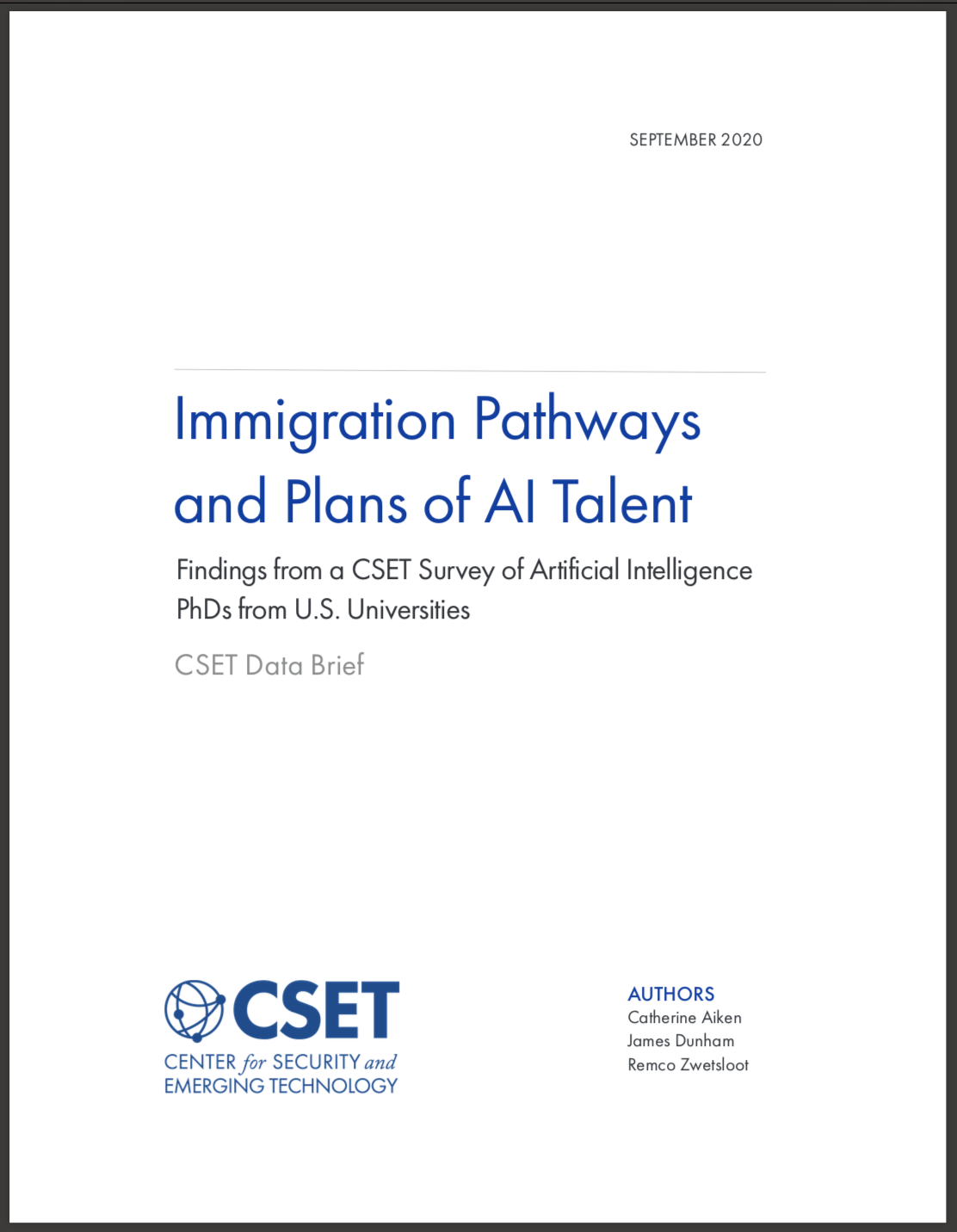Executive Summary
Much debate surrounds immigration policy and the AI workforce in the United States.1 A better understanding of the immigration trajectories and plans of AI talent can inform policies that effectively recruit and retain top AI talent. To explore the immigration paths of AI talent, we surveyed recent graduates from top-ranking AI PhD programs in the United States about their location preferences, career motivations, and immigration plans.2 We asked both U.S. citizens and non-citizens about their decisions to pursue a PhD in the United States and whether to remain in the country after graduation, as well as their future prospects of moving to another country. We inquired with non-citizens in particular about their immigration status and plans. We received responses from 254 AI PhDs, a representative sample in terms of gender, nationality, and current country of employment.3
Results indicate that:
- AI talent finds the United States an appealing place to study and work. AI talent is drawn to the United States for the high quality of education, and PhDs were motivated to stay for the location and professional opportunities. Nearly all surveyed AI PhDs currently work in the United States or plan to return at some point in their career.
- AI PhDs working in the United States plan to stay. Both U.S.-citizen and non-citizen respondents working in the United States report low likelihoods of moving to another country. Among those who are not currently U.S. citizens, 74 percent plan to apply for permanent residency or citizenship when eligible.
- A majority of AI PhDs who left the United States were motivated by family obligations and/or professional opportunities abroad. Job opportunities abroad were extremely relevant to 60 percent and family obligations abroad were extremely relevant to 57 percent of AI PhDs who left the United States. In their own words, about half cite family-related reasons as a primary driver in their decision to leave while more than a third say specific research or job opportunities motivated them to leave the United States.
- About a third of AI PhDs who left the United States considered immigration highly relevant to their decision to leave. When providing reasons for leaving in their own words, 23 percent identified immigration-related concerns, while 33 percent selected the U.S. immigration system as an extremely relevant factor in the decision to leave.
- A majority of non-citizen AI PhDs working in the United States experienced significant difficulties with the U.S. immigration system. 60 percent of AI PhDs working in the United States who are not U.S. citizens report difficulties with the U.S. immigration system, compared to 12 percent of AI PhDs who are non-citizens working in other countries. Of non-citizen AI PhDs in the United States who reported difficulties, 44 percent said those difficulties stemmed from visa issues for their spouse or family member and 77 percent said their immigration difficulties made them more likely to leave the United States.
- AI PhDs who left the United States remain highly mobile. AI PhD respondents working outside the United States report high probabilities of moving to another country. Non-citizen AI PhDs working outside the United States are more likely to be temporary residents without plans to apply for permanent residency or citizenship, compared to non-citizens working in the United States.
Download full data brief
Immigration Pathways and Plans of AI Talent- Zachary Arnold et al., “Immigration Policy and the U.S. AI Sector” (Center for Security and Emerging Technology, September 2019), https://cset.georgetown.edu/wp-content/uploads/CSET_Immigration_Policy_and_AI.pdf.
- We identified the top 20 AI programs at U.S. universities using U.S. News & World Report’s “Best Artificial Intelligence Programs,” see https://www.usnews.com/best-graduate-schools/top-science-schools/artificial-intelligence-rankings. For additional information on the survey methodology, see Appendix. We acknowledge that AI PhDs who studied in the United States represent only one subset of the AI talent pool. We focus on this population due to 1) our interest in understanding educational and career decisions and 2) scoping limitations.
- The survey was sent to 2,325 U.S. AI PhDs for an 11 percent response rate, calculated according to American Association for Public Opinion Research’s minimum response rate (RR1): the number of completed surveys divided by the number of eligible units in the sample, including cases of unknown eligibility (AAPOR Standard Definitions 2016). Accounting for instances of known invalid emails, the response rate increases to 12 percent. Sample representativeness is based on comparisons with CSET data on U.S. AI PhDs and recent research on AI talent. For more discussion of sample representativeness, see Appendix.
